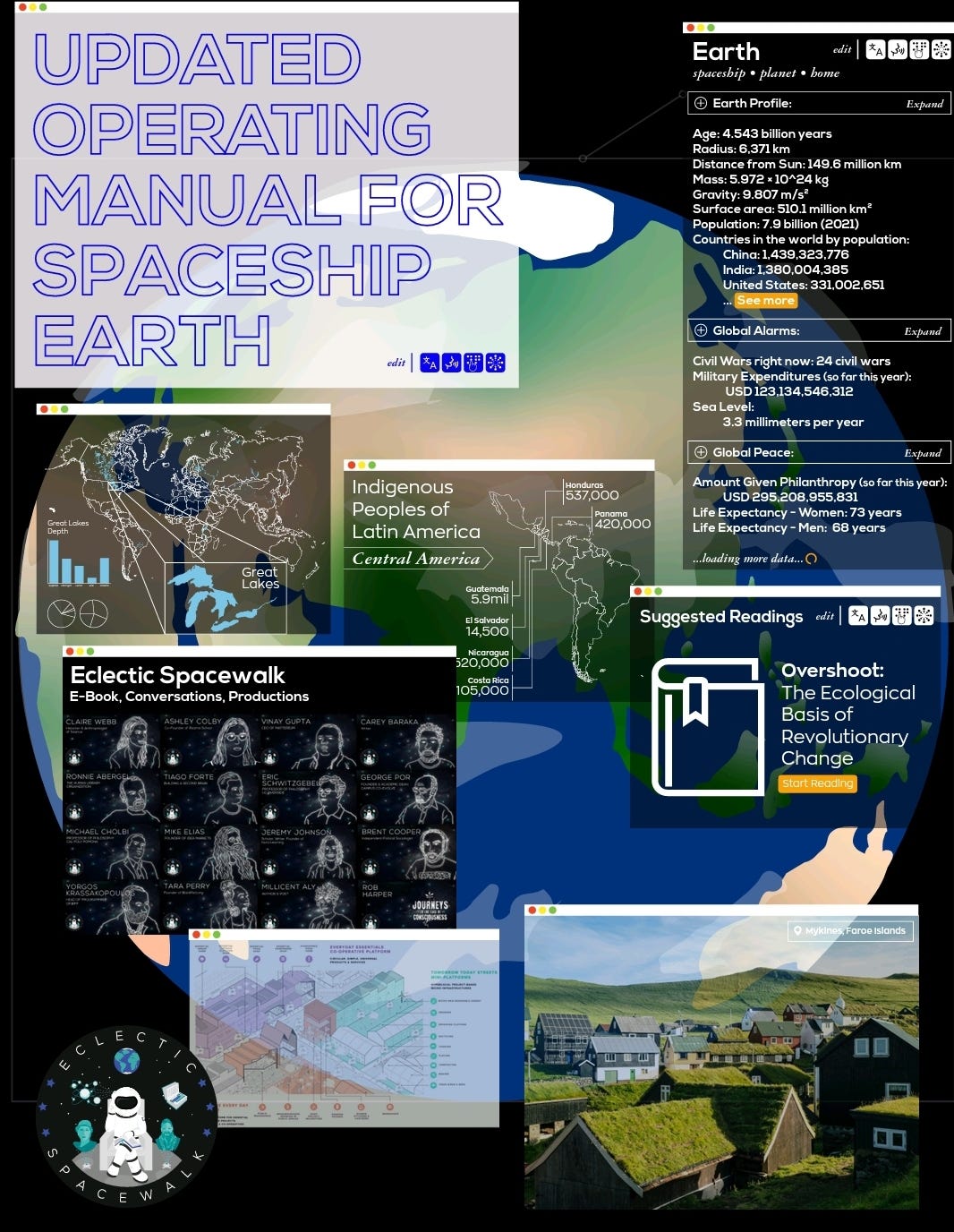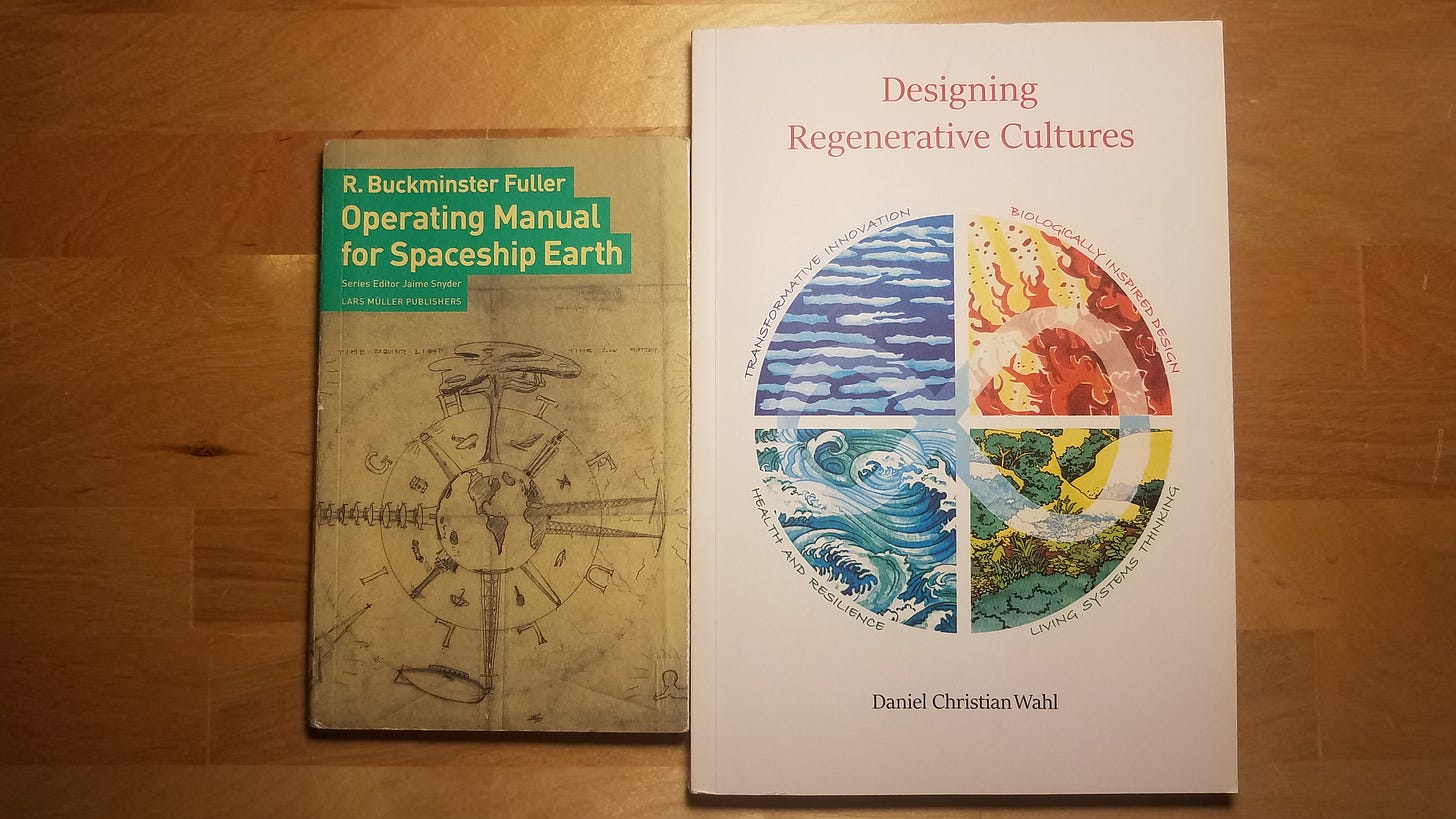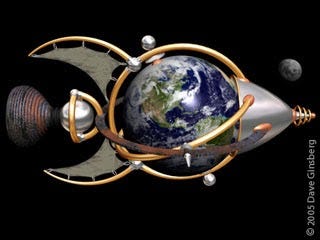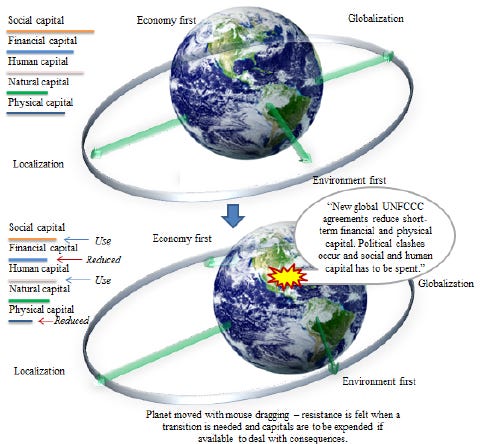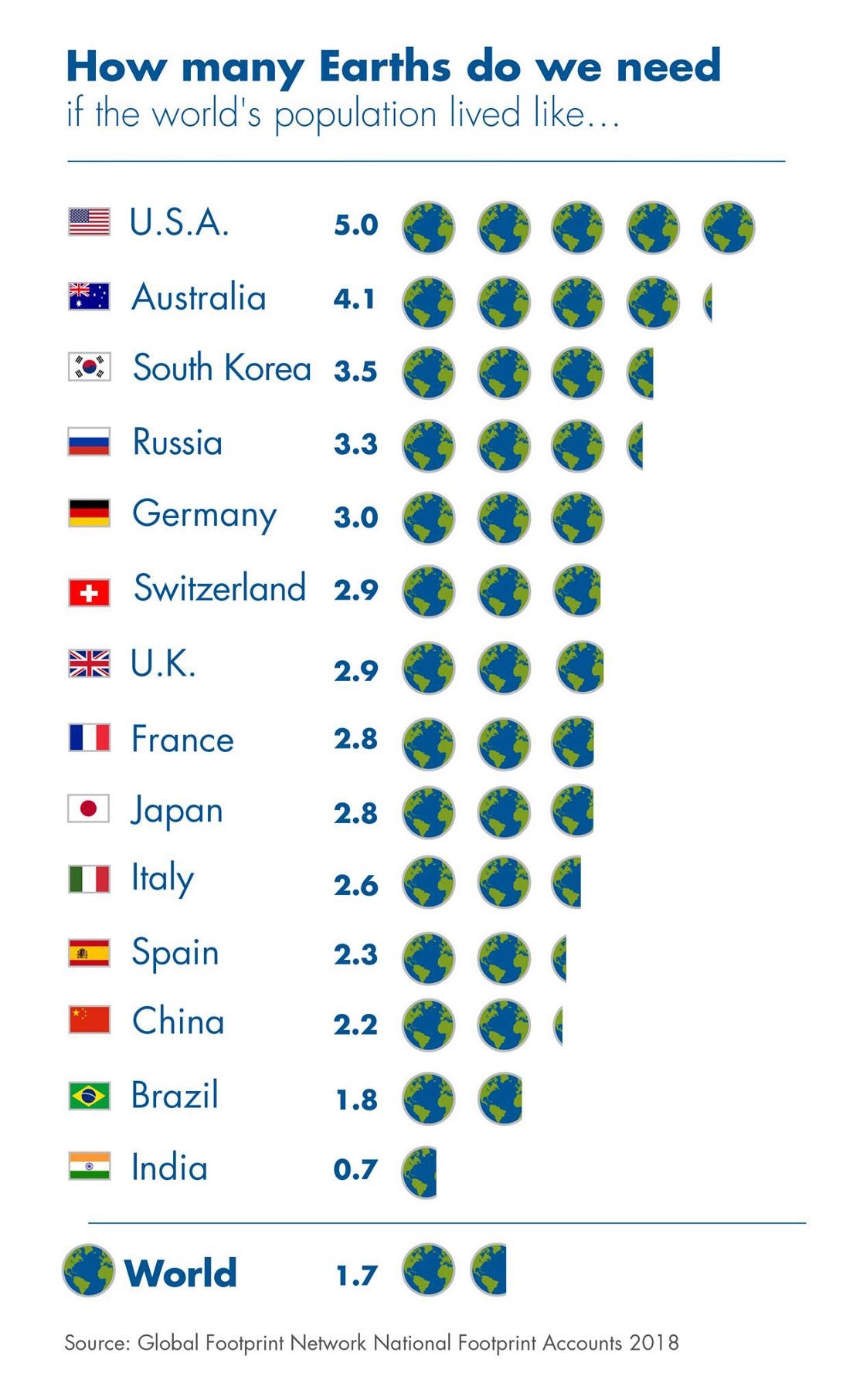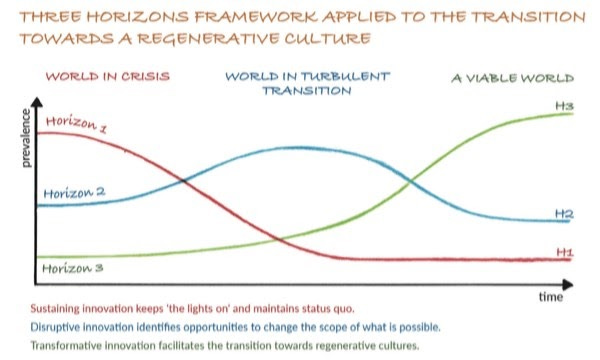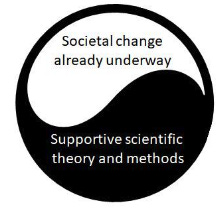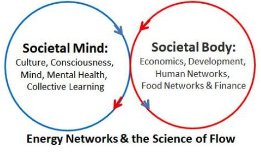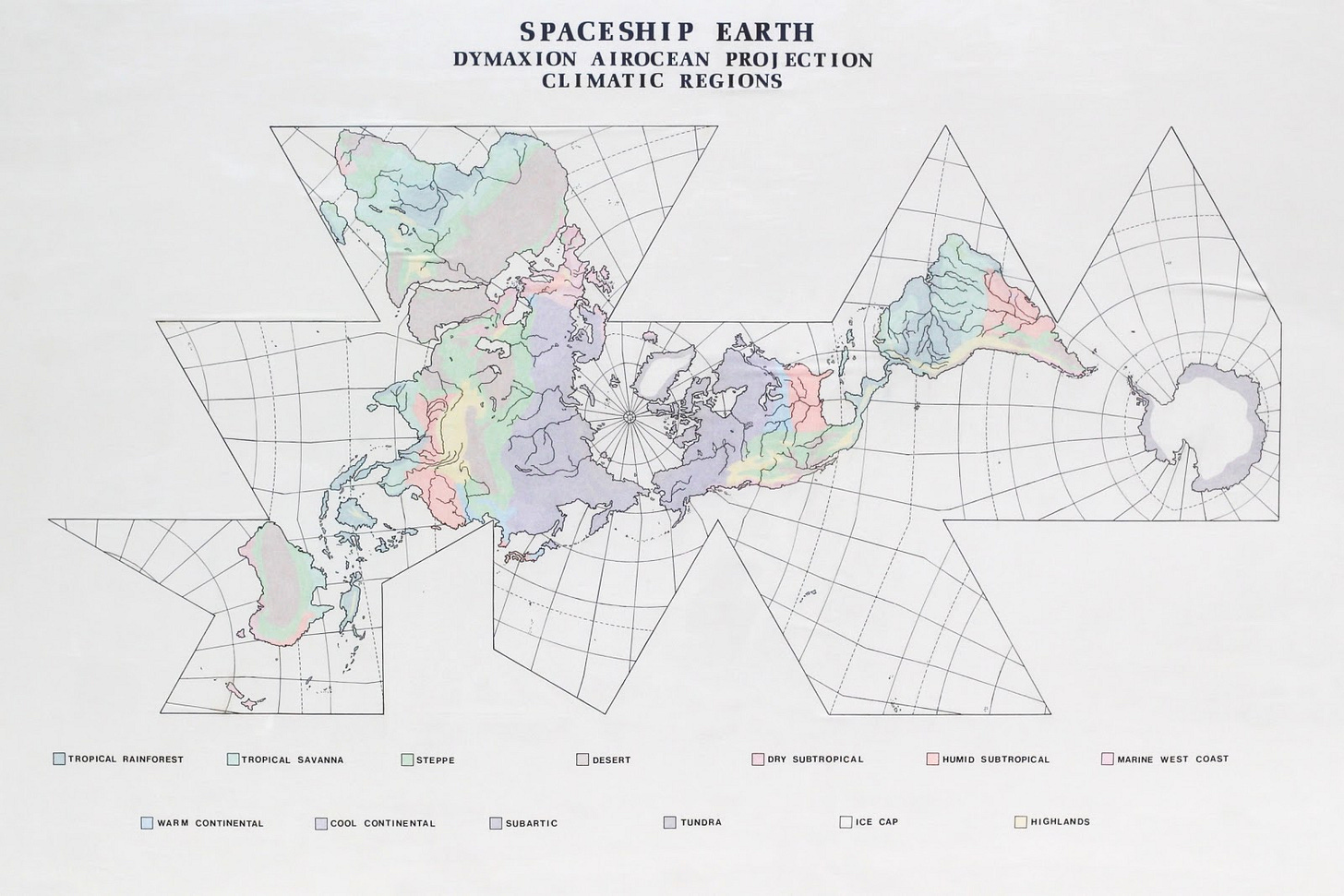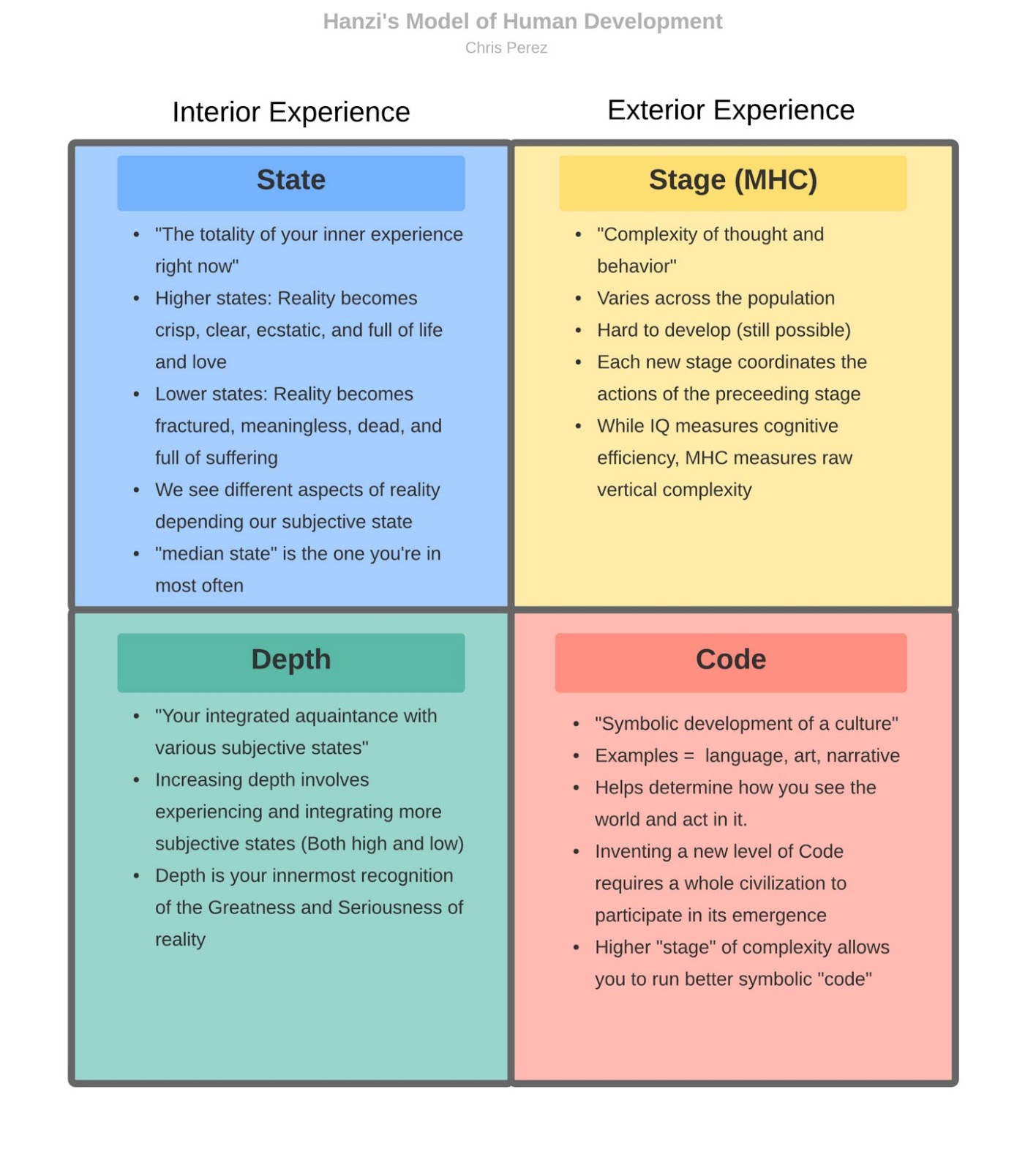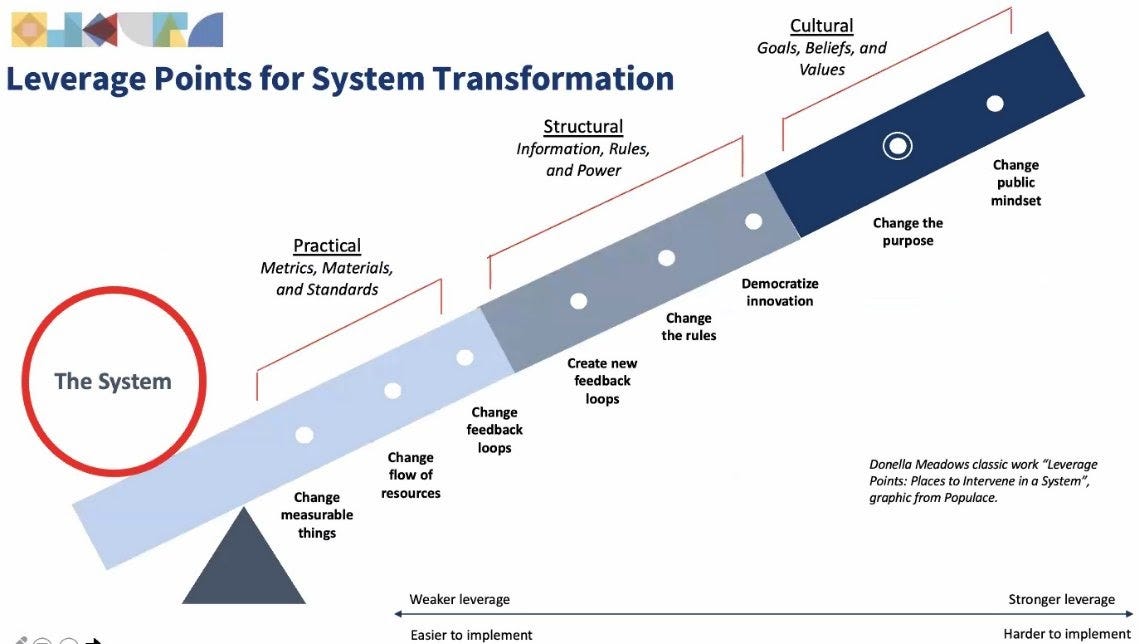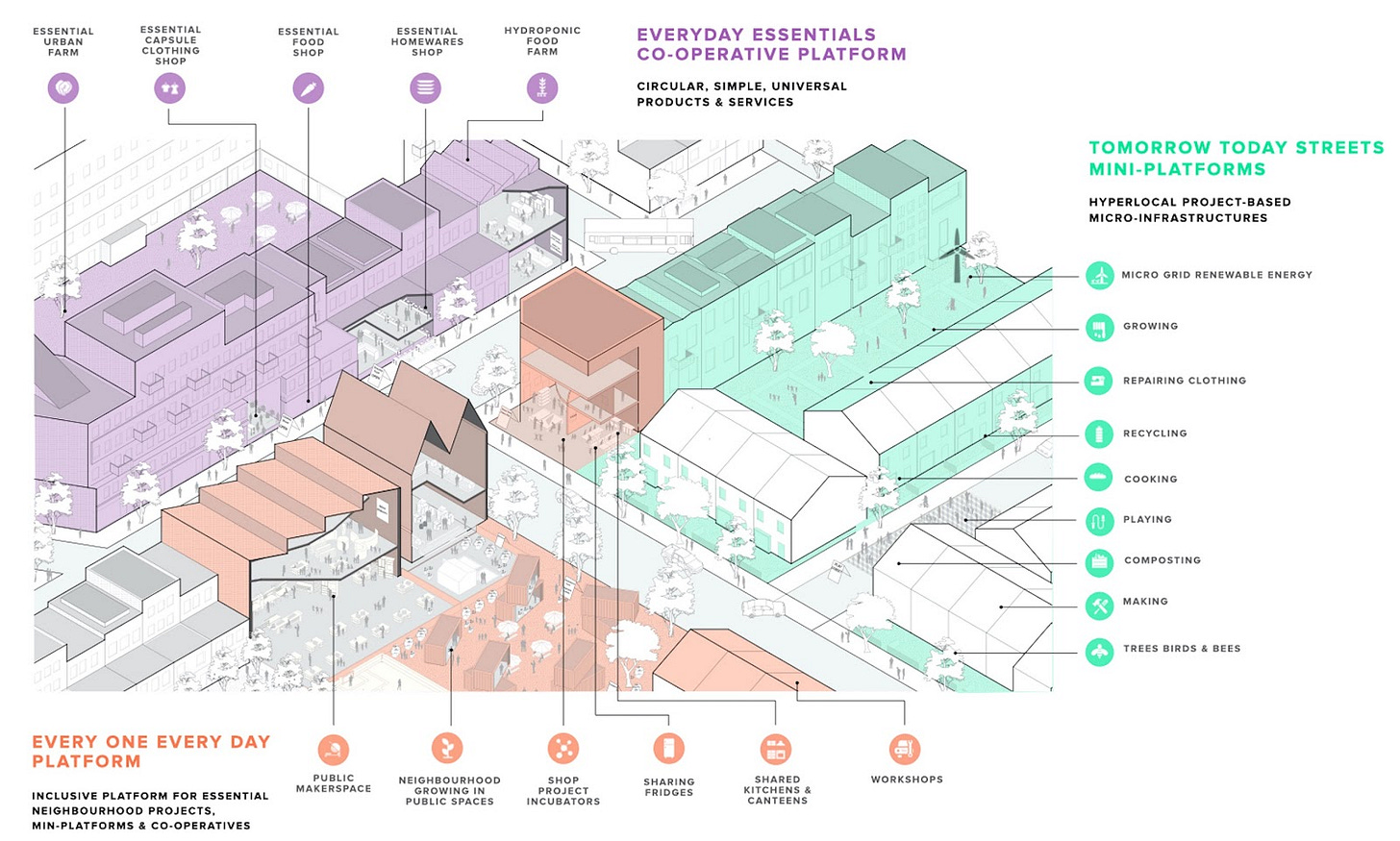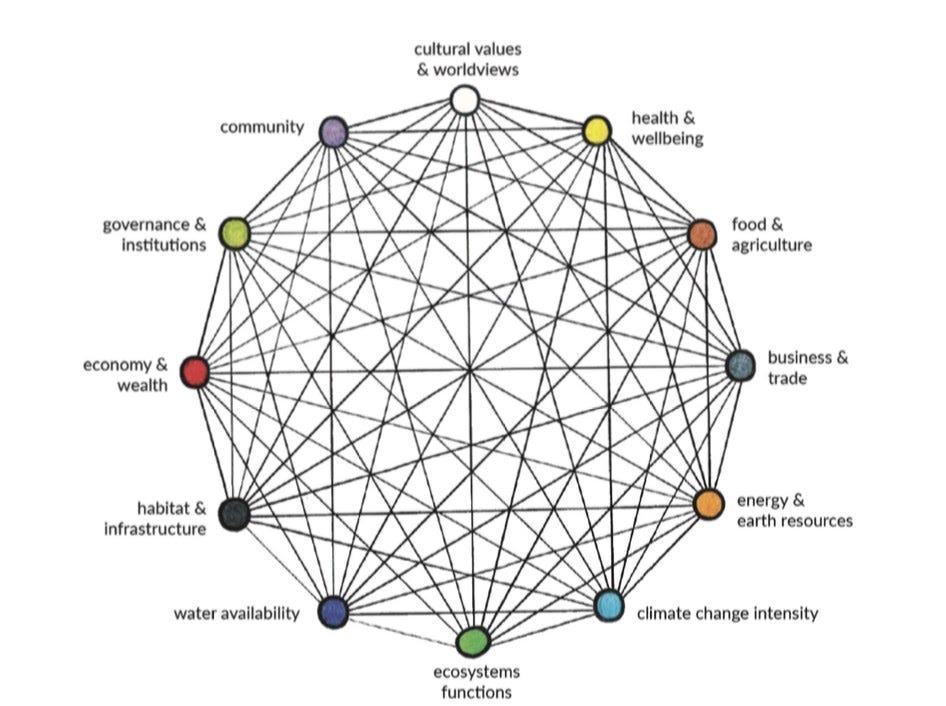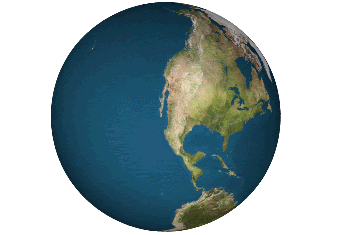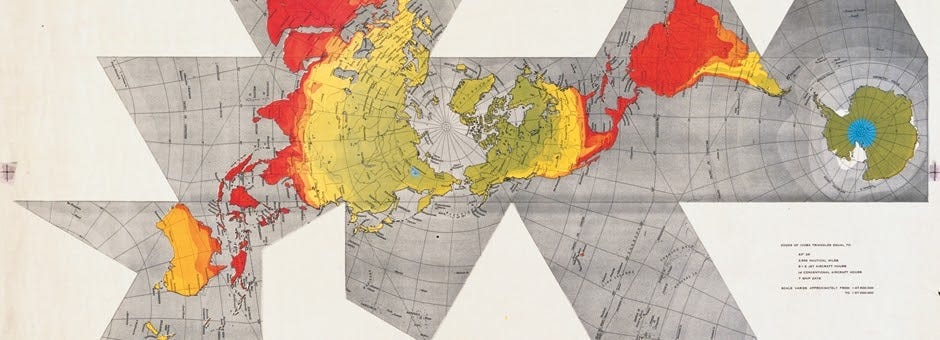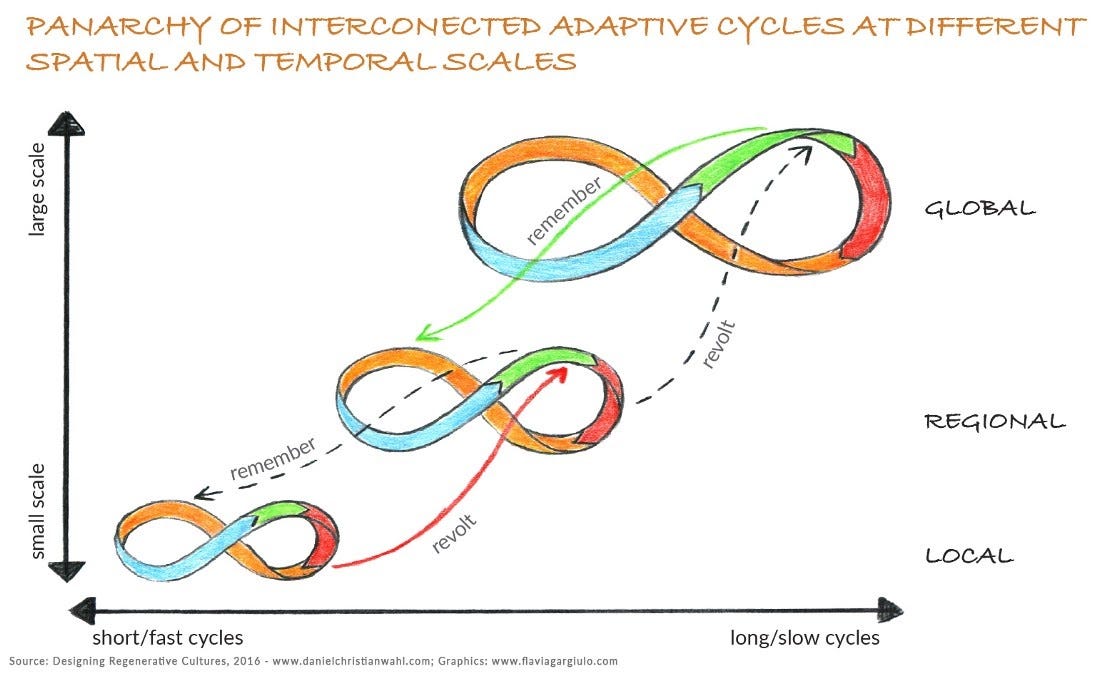Eclectic Spacewalk #11 - Updated Operating Manual for Spaceship Earth
An updated version of Operating Manual for Spaceship Earth will not be a book, but a collection of 1000s of local cultures & memories based in Anticipatory Design Science and GLOCAL inter-relatedness.
Author Note: This is my longest post yet and not for the faint of heart, but has lots of great media content to go along with all of the text. If you want a TLDR, then just watch this video playlist series on Buckminster Fuller and his ideas.
Table of Contents:
Part I. - We are all astronauts
I. Operating Manual for Spaceship Earth
II. The highest priority of world society
III. Anticipatory Design Science education
IV. The parable of the blind men and the elephant
V. Scientific Convergence: Dealing with the Elephant in the room.
—
Part II. - Coordinated to Convergent
I. Sane vs. Insane Progress & 10 Commandments to Avoid Extinction
II. Fritjof Capra’s Heart of the Matter on UN SDGs
III. Planetary Health Lab’s Multidisciplinary Approach
IV. Bioregional Self-Sufficiency
V. The Earth Charter
—
Part III. - The Individual
I. Meta-Modern Human Development
II. Be Mindful of Compartmentalization
III. Be a Chaos Integrator/Manager
IV. Actions speak louder than words
V. Be a TrimTab
—
Part IV - 15 additional Leverage Points
I. Real Universal Human Rights that put children & indigenous cultures first
II. Learning the eight principles of Uncivilization via The Dark Mountain Project.
III. Universal Basic Everything
IV. Class Politics Fit for the Times
V. Twentieth-Century Synthesis via Yale Law Review
VI. Using Principled-Focused Evaluation via Blue Marble
VII. Learning about World Governance via The IFF World System Model
VIII. Learning about Regenerative Economies via the Capital Institute.
IX. Thinking Spatially with the Dymaxion Map
X. Learning about Evolutionary Education via the Evolution Institute
XI. Creating a real Global Commons through Peer to Peer networking.
XII. Anti-Racism through the creation of a “Black Commons”
XIII. Researching of Warm and Dark DATA
XIV. Learning about Humanitarian Data Governance via Sean MacDonald
XV. Learning how to design regenerative cultures via Dr. Wahl
Audio (2 podcasts)
Video (6 videos and 1 video playlist)
What’s Next?
Reading Time: 45-60 minutes (Read the sections you find intriguing, bookmark the media/links, and come back to anytime.)
Updated Operating Manual for Spaceship Earth—
Abstract: “An updated version of Operating Manual for Spaceship Earth will not be a book, but a collection of 1000s of local cultures and memories. We can begin creating this living database with the construction of an updated framework for the discipline of Anticipatory Design Science education, which is both Macro-comprehension AND micro-incisive. Ranging through the entire inter-related GLOCAL (Global to Local) scale.”
I.
Have you ever dreamed of being an astronaut? Well if you have, then you are in luck. You already are one! To the ones who didn’t have that dream, you are in luck! You are indeed an astronaut too. Whether you like to admit it or even realize it.
“How can this be?” you ask puzzled.
It is all a matter of perspective. What keeps an astronaut alive in the vacuum of space? A spaceship. The structure is hardened by a collection of human being’s rigor to the safety of the crew, but also the promise of trying to achieve something literally out of this world - keeping biology “alive” in the vacuum of space. A spacesuit for an EVA outside the International Space Station does the same thing - a personal body spaceship.
(Via: In Outer Space without a Space Suit?)
Take that idea and extrapolate it to the largest known spaceship we know, Earth!
“We are all astronauts!” exclaims one of my personal idols Buckminster Fuller or Bucky for short, in his book Operating Manual for Spaceship Earth. (First Published in 1969.)
This view harkens back to what astronauts experience as “The Overview Effect.” A cognitive shift that happens when you reach the limits of outer space and look back at our home planet Earth. The space human now has four new pillars of understanding washing over them: Earth hangs in a void, the thinness of our atmosphere keeping out that void, the non-confirmation of man-made borders & confirmation of ONLY geographic borders, and lastly the strong bond with Earth, their fellow humans, and the need to protect our planet. You can read more in our The Overview Effect post. Bucky had a knack for seeing things as they were, and this was no different.
“I now see the Earth realistically as a sphere and think of it as a spaceship.”
(Via: http://rejourney.blogspot.com/2012/05/spaceship-earth-ethic.html)
—
II.
Ok, dear reader, so now that we see the Earth as a spaceship, we can begin to construct an operating manual for it. But what exactly is our goal? We cannot just go on willy-nilly, we need some direction. Or do we? What does Bucky say is the most important criterion? “
“...the highest priority of world society at the present moment is a realistic economic accounting system.”
Bucky, not knowingly, laid down some of the foundations for Bruno Latour’s “Down to Earth” terrestrial politics.
So, a realistic economic accounting system should be the highest priority of world society.
Ok, great! Who controls it? The answer to that important question is the central issue in moving forward, and our current answers, even Bucky’s from 50 years ago, are not viable for the future, “The result is an increasing number of UFO hallucinations of sovereign states dating backward and forwards and round in circles, getting nowhere, at an incredibly accelerating rate of speed.”
Bucky puts the situation in context with the current players in our global cultural situation, “Paradoxically, at the present moment our Spaceship Earth is in the perilous condition of having the Russians sitting at one set of the co-pilots flying controls while the Americans sit at the other. France controls the starboard engines, and the Chinese control the port engines, while the UN controls the passenger operation.”
So the answer to who controls it? No one & everyone. The only explicit goal is “Making the world work for 100% of humanity.” Everyone is responsible, but no one person is responsible. Bucky named those major players back in 1969, and to the consternation of progressive thoughts that other countries would become global powers by now or the playing field would be more democratized has not really changed at all.
Watch and learn more about Buckminster “Bucky Fuller” in this video playlist:
—
III.
The reader, having their interest piqued, will for sure by now be thinking of, “Again, ok, sure, but how??”
By constructing an updated framework for the discipline of Anticipatory Design Science education that is both Macro-comprehension AND micro-incisive. An updated version of an Operating Manual for Spaceship Earth will not be a book, but a collection of 1000s of local cultures and memories.
Rural areas are the next key and hope for true beginnings of a just future for 100% of humanity. Controlled not by a centralized top-down hierarchy, but a collective bottom-up of individual communities through an “overview effect” framework of understanding Earth’s finite limit of resources, an honest historical account of colonialism, imperialism, and racism in conjunction with economic systems that have created a baseline unfair world up until now, as well as the unwavering commitment to the knowledge that we can and should make the world work for 100% of humanity because we for the first time in human history are capable of it.
Our current “Earth Dashboard” is rudimentary, but diagnostics are slowly coming online. Our next decisions will have dis-proportional consequences in terms of risks, due to first-mover principles, so we desperately need to employ the precautionary principle proportionally at the beginning of this transition to offset as much as possible.
—
IV.
I will end this first section with the parable of “The blind men and the elephant.” A group of blind men comes across an elephant, which none have ever seen or heard of before, and try to learn, conceptualize what exactly is the thing that they just came across. Each blind man feels a separate part of the elephant and describes what they each subjectively experience. One person would be feeling the tusk, another a leg, another an ear, and another the trunk. Each one would be correct in thinking that there is a distinct part of the elephant that they are touching but it would be incorrect to assume that their part is “more truthful” than the other people’s experience of what they themselves are touching - which would be different. The moral of the parable is that humans have a tendency (unconsciously or not) to claim absolute truth based only on their subjective, limited experience at the same time ignoring other people’s experiences which might be just as true.
—
V.
Let’s link the parable to Operating Manual for Spaceship Earth. Back when OMSE was first published in 1969, humanity had an isolated view of the earth and its place within the cosmos. With the advent of modern communication and the globalization of commerce, we have coordinated resources, governments, and peoples together for the first time at this large of a scale. Due to our current status of surviving during the Anthropocene, it seems the only way to continue to survive AND THRIVE, is updating our view once again from isolated to coordinated into one of convergence.
The above graphic comes from the paper Scientific Convergence: Dealing with the Elephant in the Room.” Isolated, coordinated, and convergent views of scientific collaboration. Circles represent independent views of individual disciplines. Scientists operating under the convergent view wholly collaborate with colleagues from other disciplines, fully integrating and coordinate their research activities. The distinct scientific disciplines converge here to provide the greatest understanding of the underlying problem,” say the authors.
Just like the scientific community needs to upgrade it’s modeling to operate, “under the convergent view (by) wholly collaborating with colleagues from other disciplines, fully integrating and coordinating their research activities." We humans desperately need to continue to work towards a convergent view of our species, our home planet and the biosphere, as well as any plans for our continued future.
—
Part II - Coordinated to Convergent
Let us continue with the elephant parable, if only for a transition into the next part of the essay. Back in Bucky’s time, Humanity was at best equal to the isolated view of itself, with some instances of a coordinated view of things in our environment but mostly in the applied sciences. As L.M Sacasas points it in his essay for the New Atlantic; Analog City, Digital City, the digital city that we have been living in since the early 70s is not exactly any better than the analog city most rages against that preceded the advent of modern technology, “We seem set upon interlocking trajectories: of ever-greater swathes of the human experience being computationally managed, and of intractable human subjects increasingly breaking down or revolting against these conditions.”
These conditions are being brought about due to our increased knowledge of Earth’s biosphere metrics and what constitutes a “good” or worthwhile human experience, along with power dynamics to organize it all. Today in 2020, we may have only begun to scratch the surface of what it means to live a worthwhile human life and its contents will have to be investigated further in a different essay. The contents of this essay will expand on the other reason for today’s conditions, the increased knowledge of Earth’s biosphere that would knock Bucky over with its minute detail. With websites like Earth Dashboard, anyone with an internet connection can dissect the earth into its component parts and layers with incredible efficiency. And even if you don’t have an internet connection the lowest common denominator of knowledge in books has to have risen.
As this knowledge has been democratized over the past few decades, the once radicals screaming about the loss of biodiversity, climate change, and living in the Anthropocene have now been vindicated as they saw the writing on the wall in their data years and years before the mainstream narrative of needed change caught on. That data is now available for all, and it is a great thing. However, without a synthesis, the regular person will get lost in the weeds. (Trust me, I know from personal experience.) But there is a lifeline! The seminal text in synthesizing all of our resident Earth Biosphere data in a way that makes you want to get up and do something is OVERSHOOT: The Ecological Basis of Revolutionary Change.
In the Preface, the author William R. Catton, Jr explains what Overshoot means and why he wrote the book: “In a future that is as unavoidable as it will be unwelcome, survival and sanity may depend upon our ability to cherish rather than to disparage the concept of human dignity. My purpose in writing this book has been to enhance that ability by providing a clear understanding of the ecological context of human life. It is axiomatic that we are in no way protected from the consequences of our actions by remaining confused about the ecological meaning of our humanness, ignorant of ecological processes, and unmindful of the ecological aspects of history. I have tried to show the real nature of humanity's predicament not because understanding its nature will enable us to escape it, but because if we do not understand it we shall continue to act and react in ways that make it worse. End-of-chapter notes are provided to document or clarify points about which readers may feel reasonable skepticism. A list of selected references is also provided at the end of each chapter to satisfy appetites for further knowledge which I trust the chapter content may arouse.”
(Via Insane vs. Insane progress talk)
The founding thesis is: if you add up all of Earth’s people (over 7 billion) and then add up all of Earth’s resources you wouldn’t have enough resources for all the people at the current rate we consume before they can regenerate again. At our current rate, we consume 1.7 Earths. And if you are reading this, you are most likely a bigger part of the problem then you would care to admit. Hey, it’s me too, so I am no better!
(Via: Dr. Daniel Christian Wahl’s post)
Another way to easily visualize this is to add up all the Earth’s resources and divide them up equally into days of the year, then using our current consumption rate ask: what day of the year would you run out of resources? That is our “Earth Overshoot Day (and) marks the date when humanity’s demand for ecological resources and services in a given year exceeds what Earth can regenerate in that year.”
This year in 2020 that day is August 22nd!
We now have our coordinated view established. We know some facts through data and experiment, and also have the context of what that means moving forward into the future. But, we cannot stop here. We need to continue to a convergent view of our current predicament. We know that business, as usual, isn’t going to cut it, and now you should be skeptical of technology or innovation being our savior. We need a “third way.” I believe that the third way has to be first established as a viable option to most who think in only dichotomic extremes.
Bill Sharp’s Three Horizons of Innovation and Culture Change comes to mind. I first heard of the Three Horizons methodology through Dr. Danial Chistian Wahl who took it one step further, “Within the context of the transition towards regenerative cultures we introduce a value bias into our use of the Three Horizons methodology: solutions that create conditions conducive to life and establish regenerative patterns are valued more highly than those that don’t.”
As Thea Snow explains in her post on the Three Horizons, we are beginning to live the same questions together,” It can help us to structure our collective exploration as we start living the questions together as conscious participants in this transition. In this context, the first horizon (red) represents the currently prevalent systems that are beginning to show symptoms of decline and shortening cycles of crisis and temporary, but never fundamental, recovery.
“In other words, Horizon 1 is ‘business as usual’, or ‘the world in crisis’ (H1). It is characterized by ‘sustaining innovation’ that keeps ‘business as usual’ going. Horizon 3 (green) is how we envision a ‘viable world’ (H3). We may not be able to define this future in every detail — as the future is always uncertain — yet we can intuit what fundamental transformations lie ahead, and we can pay attention to social, ecological, economic, cultural and technological experiments around us that may be pockets of this future in the present. Horizon 2 (blue) represents ‘world in transition’ (H2) — the entrepreneurial and culturally creative space of already technologically, economically, and culturally feasible innovations that can disrupt and transform H1 to varying degrees and can have either regenerative, neutral or degenerative socio-ecological effects.”
So how do we pull out of the H1 nosedive, eventually going from H2 to H3 and making the ultimate transition from recycled to regenerative?
What do we do about Overshoot?
How can we multi-solve, as Dr. Elizabeth Sawin says, our interrelated and interconnected global issues?
I believe Michael Dowds’s Reality Rules: Ten Commandments to avoid extinction, Fritoj Capra’s systemic thinking on the UN Sustainable Development Goals, Planetary Health Lab’s goals and mission statement, a move to Bioregionalism, and instituting The Earth Charter globally could provide at least some answers! However, let me repeat what I said at the beginning of the essay. There is no “one” book or way or answer to our current predicament while we steward our species in a transition phase that could ultimately decide our collective fate.
An updated version of an Operating Manual for Spaceship Earth will not be a book, but a collection of 1000s of local cultures and memories. The below are by no means comprehensive, but a start to get the reader’s brain firing.
—
I.
Writer and speaker Michael Dowd has four key points that we have to consider when we think about sane vs. insane progress and how to achieve it:
1. “How we define and measure ‘progress’ determines our behavior and what kind of world we are leaving our grandchildren and other species.
2. Hoping for perpetual progress via techno-fix ‘solutions’ fosters complacency instead of responsible, pro-future actions.
3. Problems caused by economic growth and development will not be solved by more of the same; indeed, our predicament will worsen.
4. Understanding ecology, energy, and history undermines expectations that human ingenuity, technology, or the market can save industrial civilization.”
In response to those four considerations he has come up with Reality’s Rules: Ten Commandments to Avoid Extinction. These are supposed “Grace Limits for the 21st Century (conditions of Existence).”
Stop thinking of me as anything less than the voice of undeniable and inescapable Reality.
Stop thinking of ‘divine revelation’ and ‘God’s word’ apart from evidence.
Stop thinking of Genesis, or your creation story, apart from Big History.
Stop thinking of theology apart from ecology
Stop defining and measuring ‘progress’ in short-term, human-centered
Stop allowing the free of subsidized polluting of the commons.
Stop using renewable resources faster than they can be replenished.
Stop using non-renewable resources in ways that harm or rob future generations.
Stop exploring for coal, oil, and natural gas - keep most of it in the ground!
Stop prioritizing the wants of the wealthy over the needs of the poor.
—
II.
The UN Sustainable Development Goals are 17 goals that “address the global challenges we face, including those related to poverty, inequality, climate change, environmental degradation, peace and justice towards a more sustainable future.” All aiming to be achieved by 2030. Judging as that is only 10 years from now, we had better listen up to famed physicist and complexity scientist Fritjof Capra who has four transformative actions that are crucial to assure a sustainable future:
“Shifting from quantitative to qualitative growth, inspired by the systems in nature.
Becoming ecologically literate in order to design sustainable communities;
Recognizing the nature of systemic solutions, with agroecology as an outstanding example; and
Adopting a new Earth ethics, such as the one summarized in the Earth Charter.” (SEE V BELOW)
He goes on to stress the importance of looking at our goals through a systems thinking lens, “The state of the world today, most evident is that none of the global problems (energy shortages, environmental degradation, climate change, economic inequality, violence & war). None of these problems can be understood in isolation. They are systemic problems. They are interconnected and interdependent. When we aggravate any one of them, the effect spread through the entire system. Increasing and diversifying the other problems.”
—
III.
Planetary Health Lab answers Capra’s challenge as an example of “using a “systems” lens to develop innovative solutions to thorny problems in fields from business and education to medicine and urban planning. Thanks to computers, a systems revolution is also sweeping through every field of science: anthropology to physics. These shifts go together. The science transforms our understanding of everything from human nature to the rules of economic vitality, while societal reforms ground this vision in a foundation of practical solutions.”
They use a multidisciplinary approach because “planetary health is a systemic affair, it requires an integrated multidisciplinary approach. Goal is to gather work from as many relevant disciplines as possible. We group this work into two categories.”
Societal Factors:
Paradigms, Culture, Consciousness, Mind, Mental Health & Collective Learning
Social and Behavioral psychology
Philosophy of mind/Consciousness Studies
Neuroscience
Cognitive Science
Ecological Psychology
Climate Psychology
Brain-based education
Policy-driven Factors:
Economics, Development, Finance and other networks
Political-economics
International Development
Agriculture
Urban planning
Human Networks
Food Networks
Mental Health
Healthcare innovation
Ph-LAB consist of a large group of partners, collaborators and advisors from a range of different disciplines and professions, ranging from psychology, cognitive science, neuroscience, medicine, economics, natural science, philosophy, ecology, and international development.
Outcomes sought:
Short-term goals:
Establishment of a diverse network focused on mental health and planetary health to facilitate multidisciplinary dialogue, sharing of information, analysis of underlying linkages and a clearer understanding of the underlying system and its related challenges.
Documentation of existing and emerging solutions to address mental health challenges through a planetary health lens.
Dissemination of Lab findings to a broad audience
Medium-term goals:
Support/facilitate the uptake of solutions by key stakeholders, such as academia, medical/nursing profession, government, and urban planners.
To write a research report and policy brief addressing the problem.
To run seminars, workshops and conferences to attract global partners to connect and disseminate information.
Long-term goals:
To develop innovative and high quality programs for health policy.
To work closely with a select group of scientists and organizations to augment innovative policies to address problems.
To provide a forum for the key exchange of ideas.
To influence policy debates affecting planetary health by bringing together interdisciplinary researchers, health technological entrepreneurs and strategic representatives.
To create fruitful research links between experts in global health in the academy and researchers looking at aspects of environmental health in other research faculties.”
—
IV.
Instead of seeking a Ricardian comparative advantage through global trade integration and rentier economies, the new social imperative will be for regions to become as self-sufficient as possible in the production and distribution of resources within their own eco-regions. Rather than maximizing total assets through a macroeconomic calculus, communities will focus on maximizing supply for the common good, producing and distributing resources according to the natural functions and rhythms of their environment.
Self-sufficiency means staying within the local or regional carrying capacity and taxing, not the value that people add to the commons, but the value they take from the commons. This creates dividends for citizens and the means of regenerating their resources. When people recover the capacity to sustain their population directly through the region where they live, there is no need to seek comparative advantage over the resources of others. Only when this is not possible would they look outside of their bioregion for trade...
(Via: The Fuller Challenge Website)
It’s important to remember that the members of local and regional communities are much closer to resource distribution problems than national governments, and a far richer source of local knowledge, innovation and ways of meeting human needs equitably and ecologically. For example, local communities have pioneered water management techniques like rainwater catches and drip irrigation which reduce water evaporation, and the recycling of household sewage for agriculture rather than publicly dumping the waste and polluting aquifers and wells.
What bioregional democracy requires is collaborative decision-making within a resource area. This is not such a novel idea. Identifying and building bioregional coalitions is a phenomenon that predates private property and sovereign boundaries. In fact, communities for resource management have historical roots all over the world, ranging from the Arab waqf, the Jewish kibutz and the Brazilian cooperative to the European guild, the English commons and the communitarian practices in hundreds of indigenous cultures.
Before long, governments will recognize the advantages of redistributing the power for resource management. As citizens invest in their commons and the commons pay them dividends, the extreme competition for resources and the potential for violence will decline because the commons are available for everyone’s use. To make this possible at regional levels, institutional mechanisms must be created to share power within and across borders for the common management of resources.
This could take the form of confederations or associations for bioregional cooperation, especially in those areas of the world, like the Middle East, Central Asia and South Asia, which face political instability complicated by a lack of water and food. In turn, this could lead to the creation of Regional Cooperation Councils and the authorization of Bioregional Conventions which sanction partnerships between nations and their transborder communities for the sharing of resources.
The sea (or river, lake, reservoir, estuary, wetland or ocean) is where a watercourse converges after supporting life in a watershed. Upon reaching the end of its natural run, this water is released into a new cycle of activity. By applying the patterns of a flowing watershed, society can also develop accountable systems for the peaceful rotation of governmental power.
The safekeeping of resource areas requires the support of democratic governments which ensure political diversity in lasting and effective ways. Protecting transborder commons is not possible without governments which are credible and durable. Only sustainable democracies can ensure the public security which bioregional communities need to provision resources for present and future generations and to stabilize their consumption within the natural flows of the biosphere.”
—
V.
THE EARTH CHARTER
“PREAMBLE
We stand at a critical moment in Earth's history, a time when humanity must choose its future. As the world becomes increasingly interdependent and fragile, the future at once holds great peril and great promise. To move forward we must recognize that in the midst of a magnificent diversity of cultures and life forms we are one human family and one Earth community with a common destiny. We must join together to bring forth a sustainable global society founded on respect for nature, universal human rights, economic justice, and a culture of peace. Towards this end, it is imperative that we, the peoples of Earth, declare our responsibility to one another, to the greater community of life, and to future generations.
Earth, Our Home
Humanity is part of a vast evolving universe. Earth, our home, is alive with a unique community of life. The forces of nature make existence a demanding and uncertain adventure, but Earth has provided the condition essential to life's evolution. The resilience of the community of life and the well-being of humanity depend upon preserving a healthy biosphere with all its ecological systems, a rich variety of plants and animals, fertile soils, pure waters, and clean air. The global environment with its finite resources is a common concern of all peoples. The protection of Earth's vitality, diversity, and beauty is a sacred trust.
The Global Situation
The dominant patterns of production and consumption are causing environmental devastation, the depletion of resources, and a massive extinction of species. Communities are being undermined. The benefits of development are not shared equitably and the gap between rich and poor is widening. Injustice, poverty, ignorance, and violent conflict are widespread and the cause of great suffering. An unprecedented rise in the human population has overburdened ecological and social systems. The foundations of global security are threatened. These trends are perilous—but not inevitable.
The Challenges Ahead
The choice is ours: form a global partnership to care for Earth and one another or risk the destruction of ourselves and the diversity of life. Fundamental changes are needed in our values, institutions, and ways of living. We must realize that when basic needs have been met, human development is primarily about being more, not having more. We have the knowledge and technology to provide for all and to reduce our impacts on the environment. The emergence of a global civil society is creating new opportunities to build a democratic and humane world. Our environmental, economic, political, social, and spiritual challenges are interconnected, and together we can forge inclusive solutions.
Universal Responsibility
To realize these aspirations, we must decide to live with a sense of universal responsibility, identifying ourselves with the whole Earth community as well as our local communities. We are at once citizens of different nations and of one world in which the local and global are linked. Everyone shares responsibility for the present and future well-being of the human family and the larger living world. The spirit of human solidarity and kinship with all life is strengthened when we live with reverence for the mystery of being, gratitude for the gift of life, and humility regarding the human place in nature. We urgently need a shared vision of basic values to provide an ethical foundation for the emerging world community. Therefore, together in the hope we affirm the following interdependent principles for a sustainable way of life as a common standard by which the conduct of all individuals, organizations, businesses, governments, and transnational institutions is to be guided and assessed.
THE EARTH CHARTER
PRINCIPLES
I. RESPECT AND CARE FOR THE COMMUNITY OF LIFE
1. Respect Earth and life in all its diversity
2. Care for the community of life with understanding, compassion, and love
3. Build democratic societies that are just, participatory, sustainable, and peaceful.
4. Secure Earth’s bounty and beauty for present and future generations.
II. Ecological Integrity
5. Protect and restore the integrity of Earth’s ecological systems, with special concern for biological diversity and the natural processes that sustain life.
6. Prevent harm as the best method of environmental protection and, when knowledge is limited, apply a precautionary approach.
7. Adopt patterns of production, consumption, and reproduction that safeguard Earth’s regenerative capacities, human rights, and community well being.
8. Advance the study of ecological sustainability and promote the open exchange and wide application of the knowledge acquired.
III. Social and Economic Justice
9. Eradicate poverty as an ethical, social, and environmental imperative
10. Ensure that economic activities and institutions at all levels promote human development in an equitable and sustainable manner.
11. Affirm gender equality and equity as prerequisites to sustainable development and ensure universal access to education, health care, and economic opportunity.
12. Uphold the right of all, without discrimination, to a natural and social environment supportive of human dignity, bodily health, and spiritual well-being, with special attention to the rights of indigenous people and minorities.
IV. Democracy, Non-Violence, and Peace
13. Strengthen democratic institutions at all levels, and provide transparency and accountability in governance, inclusive participation in decision making, and access to justice.
14. Integrate into formal education and life-long learning the knowledge, values, and skills needed for a sustainable way of life.
15. Treat all living beings with respect and consideration.
16. Promote a culture of tolerance, nonviolence, and peace.
—
THE WAY FORWARD
As never before in history, common destiny beckons us to seek a new beginning. Such renewal is the promise of these Earth Charter principles. To fulfill this promise, we must commit ourselves to adopt and promote the values and objectives of the Charter.
This requires a change of mind and heart. It requires a new sense of global interdependence and universal responsibility. We must imaginatively develop and apply the vision of a sustainable way of life locally, nationally, regionally, and globally. Our cultural diversity is a precious heritage and different cultures will find their own distinctive ways to realize the vision. We must deepen and expand the global dialogue that generated the EarthCharter, for we have much to learn from the ongoing collaborative search for truth and wisdom.
Life often involves tensions between important values. This can mean difficult choices. However, we must find ways to harmonize diversity with unity, the exercise of freedom with the common good, short-term objectives with long-term goals. Every individual, family, organization, and community has a vital role to play. The arts, sciences, religions, educational institutions, media, businesses, nongovernmental organizations, and governments are all called to offer creative leadership. The partnership of government, civil society, and business is essential for effective governance.
In order to build a sustainable global community, the nations of the world must renew their commitment to theUnited Nations, fulfill their obligations under existing international agreements, and support the implementation of Earth Charter principles with an international legally binding instrument on environment and development.
Let ours be a time remembered for the awakening of a new reverence for life, the firm resolve to achieve sustainability, the quickening of the struggle for justice and peace, and the joyful celebration of life.”
Part III - The Individual
Today we live in a crucible of complex forces pulling the collective, and the individuals making it up, into itself. As technologist, writer, and CEO of Mattereum Vinay Gupta states, “We are all pretty clear something is profoundly wrong with the world, and maybe with humanity itself.” He then goes on to ask, “But what is wrong, and what do we do about it?”
Before beginning to answer that question, I believe that we need to be in the right frame of mind and mental space. I also believe a “post-doom” way of thinking as a baseline would be helpful to prime us.
We have gone over five examples of moving towards a more regenerative future for the collective. A future that takes the task and responsibility of being at the controls of Spaceship Earth seriously, but doesn’t succumb to the incessant nihilism of anyone ever not being in total control. Furthermore, if ever in control of anything it is only temporary. We can only imagine such a future by forcing ourselves to think of humanity and Earth’s biosphere as interrelated psychologically and sociologically. We are all one.
I have come up with five ways of how the individual can make a personal difference that radiates through society. However, I would also like to reiterate once more that these examples are not exhaustive or comprehensive. Remember an updated version of an Operating Manual for Spaceship Earth will not be a book or a handful of useful heuristics, but a collection of 1000s of local cultures and memories. This is but a start!
I. Meta-Modern Human Development
II. Be Mindful of Compartmentalization
III. Be a Chaos Integrator & Manager
IV. Actions speak louder than words
V. Be a TrimTab
—
I.
Essayist Chris Perez created a Meta-Modern Guide to Human Development. He defines meta-modern as, “Metamodernism reconciles Modernism and Postmodernism while admitting its own impermanence. With deep irony and arrogant, well-earned sincerity, it obsoletes old epochs by matching the complexity of our chaotic world. It is thus able to dialogue with it and profoundly alter its course.”
Perez says that Hanzi is the most unique of the theorists he has read because of how Hanzi distinguishes between types of development unlike anyone else. Perez breaks down the guide into four quadrants of development: State, Depth, Stage, and Code.
Perez loosely defines them as “State is the quality of your inner experience right now. Depth is the integration of the states you’ve experienced. Stage is the complexity of your thought and behavior. Code is your level of symbolic development — language, knowledge, art, narratives, etc.”
“State, depth, stage and code productively guide our path without getting us stuck in magical thinking or other forms of bullshit.
This is a conversation opener: how to we distill these ideas further? Can this frame be taken into psychology to achieve greater therapeutic results? Can we bring it into education so children have a more balanced approach to being in the world?
It’s time to steal back our development from narrow-minded academics and the fickle whims of the market. Let’s co-create reality in a more sophisticated way.”
—
II.
Essayist Christopher Chase says, “Most of the problems in our world stem from how “civilized” humans have compartmentalized life in such a way as to hide reality from ourselves and other people.”
He goes on to say, “We live in an age where the delusions and ignorance of modern civilizations have become the global norm. A fantasy view of reality, what Buddhists call samsara, has been packaged, marketed, and sold to the masses by those in positions of influence and power…This has been done on purpose, has been the “operating code” of hierarchical human civilizations for thousands of years. Our leaders don’t want us to know what is really going on, with anything. This was as true of pharaohs and kings in the past as it is of large corporations, governments, billionaires, military leaders, and media elites now. The compartmentalization of knowledge and intentional hiding of facts is how those in power maintain control. They hide how food is produced, how wars create future terrorists (and civilian casualties), how education is being intentionally dumbed down, how the earth’s ecosystems are being destroyed, how politicians are corrupt, how democracy has been rigged, how debt enslaves people and wealth is accumulated unfairly.”
He challenges us to be mindful of this compartmentalization and fight against it, “Much of the chaos and destruction we see reported in the media is rooted in how billions of compartmentalized human minds are responding to the alienation, standardization, ignorance and division that has become normalized with our high-tech civilization. People are reacting fearfully to the experience of not being fully whole, not fully connected to our communities, to this incredible Universe and the wider Community of Nature that supports us (and in truth brought each of us into being).”
“People normally cut reality into compartments, and so are unable to see the interdependence of all phenomena. To see one in all and all in one is to break through the great barrier which narrows one’s perception of reality..” ~Thich Nhat Hanh
III.
In How Complex Systems Fail, Richard I. Cook, MD of Cognitive Technologies Laboratory explains in a short treatise about “the Nature of Failure; How Failure is Evaluated; How Failure is Attributed to Proximate Cause; and the Resulting New Understanding of Patient Safety.”
Complex Systems are intrinsically hazardous systems.
Complex systems are heavily and successfully defended against failure.
Catastrophe requires multiple failures - single point failures are not enough.
Complex systems contain changing mixtures of failures latent within them.
Complex systems run in degraded mode.
Catastrophe is always just around the corner.
Post-accident attribution accident to a ‘root cause’ is fundamentally wrong.
Hindsight biases post-accident assessments of human performance.
Human operators have dual roles: as producers & as defenders against failure.
All practitioner actions are gambles.
Actions at the sharp end resolve all ambiguity.
Human practitioners are the adaptable element of complex systems.
Human expertise in complex systems is constantly changing.
Change introduces new forms of failure
Views of ‘cause’ limit the effectiveness of defenses against future events.
Safety is a characteristic of systems and not of their components.
People continuously create safety.
Failure free operations require experience with failure.
Consultant Paul Millerd writes in his blog Boundless that a way for an organization to stay ahead of the exponential growth curve is to integrate chaos. Millerd says, “Instead of seeing organizations as broken, a more accurate starting point is to think of them as complex systems and instead of broken, as fragile. As the scale of business gets bigger, the hidden fragility of many organizations puts employees, customers, and society at risk.”
“To address this fragility, I want to look at organizations as “complex adaptive systems”, an idea that emerged from a field called Chaos Theory in the 1970s and 1980s. I want to push for a broader adoption of these principles and encourage a new generation of “chaos managers” to become interested in the survival and success of our institutions.”
I want to call Paul, and raise him the challenge - as well as a challenge to all - to integrate chaos not only into organization planning but also into each person’s individual lives. We can use the same principles of chaos theory that help build resilient organizations, and utilize them for our subjective selves. We understand that we live in a complex and often chaotic world, and the sooner we integrate into the more diverse ways the better. Millerd writes that “fundamentally, the chaos manager thinks about five roles.”
Emergence Architect: Increase the opportunity for changes that have large positive effects by engaging in more small experiments
Authority Aligner: Increasing the credibility of top-down leadership by focusing on personal authority in addition to positional authority.
Reality Sensemaker: Shift from the illusion of top-down control to better control though improved sensemaking, better feedback & making appropriate decisions at lower levels of the organization
Chaos Injector: Ensures that the organization is not stagnant and looks for ways to inject “energy” throughout the company
Survival Guide: Can increase the perceived credibility among employees, customers, society, and shareholders by shifting the organization’s mission to survival
Why couldn’t we do this in our own lives when we can? Why shouldn’t we?
Integrating chaos into our individual lives would be a formidable solution to a myriad of complex problems. It doesn’t necessarily solve, or even try to solve them, but it allows a mental scaffolding to gain a foothold for thought & action to solve them. Be a chaos manager at work and at life, collectively and individually.
—
IV.
In his essay, Cutting Through Spiritual Colonialism, Vinay Gupta echoes Chris Perez saying that “we live in an economy of fear,” and we need to “decomplexify our world models by making them more accurate.” His essay is “about how problems wind around each other in ways which seem insoluble, and how to pry these problems apart into soluble components.”
He goes on to say that the structure of the world incentivizes power imbalances making it easier for the individual to turn a blind eye to abuse, “we are wired to see the power and the abuse of power, but we need three vanishing points put in place to draw the world in its true perspective: technological acceleration, limits to growth, and the invisible hierarchy of abuse.” You can read the essay if you want to go further into the first two. We are going to stick with the third vanishing point: the invisible hierarchy of abuse.
So how, then, are spiritual beings to live in this world?
Vinay answers candidly while echoing Gandhi, “This ability to turn a blind eye “because we have to” is what makes the hierarchy of abuse invisible. It’s what allows a game that is almost entirely made of losers to continue to be played by everybody as if they were winning.
If there is to be real spirituality, it must come in the form of what we do, not simply the stories we tell ourselves about our lives.
Let’s go back to basics. Here is Gandhi’s list of fundamental problems.
Wealth without work.
Pleasure without conscience.
Knowledge without character.
Commerce without morality.
Science without humanity.
Religion without sacrifice.
Politics without principle.
Now, let me ask a naive question: is he wrong?”
—
V.
From one of my favorite blogs, Brain Pickings, we see Bucky at his universal best with literal practical advice, wisdom for the ages, and all while doing it with a smile and zero negativity. When you read the story below, remember his tombstone reads: “Call me Trim Tab.”
“In response to the interviewer’s question about how we can live with “a sense of the individual’s impotence to affect events, to improve or even influence our own welfare, let alone that of society,” Fuller offers his magnificent metaphor:
Something hit me very hard once, thinking about what one little man could do. Think of the Queen Elizabeth — the whole ship goes by and then comes the rudder. And there’s a tiny thing at the edge of the rudder called a trim tab. It’s a miniature rudder. Just moving the little trim tab builds a low pressure that pulls the rudder around.
Takes almost no effort at all. So I said that the little individual can be a trim tab. Society thinks it’s going right by you, that it’s left you altogether. But if you’re doing dynamic things mentally, the fact is that you can just put your foot out like that and the whole big ship of state is going to go. So I said, “Call me Trim Tab.”
The truth is that you get the low pressure to do things, rather than getting on the other side and trying to push the bow of the ship around. And you build that low pressure by getting rid of a little nonsense, getting rid of things that don’t work and aren’t true until you start to get that trim-tab motion. It works every time. That’s the grand strategy you’re going for. So I’m positive that what you do with yourself, just the little things you do yourself, these are the things that count. To be a real trim tab, you’ve got to start with yourself, and soon you’ll feel that low pressure, and suddenly things begin to work in a beautiful way. Of course, they happen only when you’re dealing with really great integrity.”
Part IV - 15 additional Leverage Points
Buckminster “Bucky” Fuller’s final words were a challenge to each and every one of us to first understand what is possible. To see clearly one must as master Yoda says, “Unlearn what you have learned.” The first step to a truly sustainable future off of fossil fuels is for individuals to “evolve consciously” and to demand from themselves, their peers, and their government a “design science revolution” to make our collective dreams of a fossil-free reality. During his long and illustrious life, Bucky could see a future of peace and tranquility if we got our act together.
“Either war is obsolete or man is. To not evolve beyond war is to choose oblivion over utopia.”
Below are the words that were on Bucky’s death when he passed in 1983. The main thesis being the need to completely turn our technology design away from weaponry and instead put it toward “livingry.” Rather than bombs, tanks, and bullets, we should be putting that innovation, manpower, and capital into making the human experience work for 100% of humanity.
“With the highest aeronautical and engineering facilities of the world redirected from weaponry to livingry production, all humanity would have the option of becoming enduringly successful. Humanity now has the opportunity, for the first time in its history, to operate our planet in such a manner as to support and accommodate all humanity at a substantially more advanced standard of living than any human beings have ever experienced.
It is a matter of converting high technology from weaponry to livingry. The essence of livingry is human-life advantage and environment controlling.
“It is now technically feasible with presently proven technology to impound and distribute to humanity the vast overabundance of our cosmic energy income — from the sun, vegetable produced alcohols, and sun-derived wind power and wave power. Through foresight and design, it is possible to phase our all further use of fossil fuels and atomic energy which comprise nature’s cosmic energy savings account. Enterprise is too narrowly focused on money-making . . . and too shortsighted to address those biggest, most important, long-time tasks that are vital to sustaining humans on board our planet.”
“Our more-with-less technology can now enable us to do what could never be done before. We can become an omni-integrated, majorly literate, unified Spaceship Earth society.”
(Via Buckminster Fuller Final Message)
Donella H. Meadows, another esteemed thinker, and influence for Eclectic Spacewalk, saw how thinking holistically meant that you could begin to have foresight on what a system might have in store for you next. You can never fully control a system, but you can dance with them!
Via our post on systems thinking, “The future cannot be predicted, but it can be envisioned with foresight, critical thinking, and a holistic approach to any mental model. All we can do is have a commitment to learning, designing, and the most important part - redesigning with the knowledge & expertise of the previous design history. The world is full of surprises, and we have to learn from each and every one!
“We can’t control systems or figure them out. But we can dance with them!”
“Stay wide awake, pay close attention, participate flat out, and respond to feedback.”
“Living successfully in a world of system requires more of us, than our ability to calculate. It requires our full humanity - our rationality, our ability to sort truth from falsehood, our intuition, our compassion, our vision, and our morality.”
So how might I, or the reader, help in the quest to demand a design science revolution? My way is through researching, compiling, synthesizing, and finally writing to champion multidisciplinary ideas and scour the world for practical examples and use cases. Leverage points are places in systems that can have disproportionate, in terms of size of the stimulus or disruption, sway, or influence. I have provided 15 more ideas, heuristics, and guidelines that could be used to make change through leverage points in a system. I must add for the final time that this list is not exhaustive or comprehensive and an updated version of an Operating Manual for Spaceship Earth will not be a book or a handful of useful heuristics, but a collection of 1000s of local cultures and memories. These are some that I think could use some more attention.
—
I. Real Universal Human Rights that put children & indigenous cultures first
Vinay Gupta says that he has “A simple plan for repairing our society.” I would tend to agree with him that we need to recognize our colonized memories in collective spirit with our deep historical indigenous roots, but also at the same time needing a new human rights framework that putting puts the rights of children first and foremost.
“We need new human rights, and this is how we get them...In short, our global rights frameworks do not adequately protect the rights of the child, and I think a model based on the rights of children would be a thousand times clearer than the SDGs, easier to apply, easier to get engagement with, and cover about half of the same territory the SDG goals do: we need both, but nobody can apply the SDGs to common every-day problem solving.
In short, making the rights of children fully explicit, and enshrining them in our legal systems may be the shortest path forwards to creating a world in which we, as adults, are also protected. But the children first: none of this is their fault, and they should be protected as best we can.
And a rights framework for children, something simple, reasonably universal, clear and easy to work with is certainly possible. We can do this.
We hold the following to be self-evident, that every man, woman, and child is born with certain inalienable rights…
So let me pull out five principles which I think are useful frameworks for this kind of analysis.
Children are inheritors of a set of global commons, including the atmosphere, the oceans, and humanity’s common knowledge base. Any child has a right to legally claim and defend these global commons which are their birthright.
this right equally well applies to adults, but given the kids will be around a lot longer than any adult, and that they have no other property, this seems important to establish first.Children ordinarily have no moral status: they are not good or evil, and their rights and privileges cannot be bound to a concept of moral reward. That is to say, concepts of “deservingness” which are typically applied when considering state aid to adults cannot be applied to children. Children just are.
This makes children an excellent place to test concepts around basic income, for example. Why would one means-test benefits which flow directly to a child or their guardians?Children have the right to inherit the basic operating machinery of the world (i.e. the carbon and water cycles) in an operable form.
Self explanatory. May also apply to disease management in some areas, deforestation and similar geographically-located natural assets are harder to put rights to. This is an extremely powerful principle. It’s slightly different from the “global commons” principle because it’s explicitly about processes, not property. I’ll get further into that distinction in a future piece.Children have the right not to be constrained by the peculiarities of their culture. They should have the right to make up their own minds about the nature of reality, without constraint of the culture they find themselves in. This is to say, adults should not have the right to impose their beliefs on children by force, coercion, or infliction of ignorance by hiding or forbidding common knowledge.
Mainly targeted at political and religious indoctrination. Again, extremely powerful.Children are the fundamental priority of the human species, generation after generation, for millions of years. They should have the right to priority in resource allocation decisions by virtue of the fact that they are helpless to earn their own resources, vote, or otherwise lobby for their own best interests.
No aircraft carriers get budgeted until the schools are pretty much as good as they can get. Without votes, children’s rights have to be more protected than the rights of adults. They don’t have the same access to legal machinery to pressure government to represent their interests, so their interests have to be enshrined at a deeper level than the rights of adults: constitutionally.
Now, I am not a constitutional scholar. Also I don’t even have kids, which makes it a little easier to be romantic about the little bastards: no parent could write this and not be sentimental about it. What I am is a moral and philosophical pragmatist, and we need a completely new language for political debate if we are going to dig ourselves out of the hole that we have gotten ourselves in here, globally. Everybody knows we are screwing everything up, and most especially, we are stealing the future from our children in so many ways.
Whether it is national debt or climate change, we are piling up unsustainable obligations to the sky knowing that the children will be the taxpayers who pay, and the ones that suffer.”
-
If Vinay covered the children aspect, I will allow the indigenous people’s speak for themselves in their 1992 manifesto, ”Indigenous Peoples Manifesto: When contemplating the contemporary challenges and problems faced by Indigenous Peoples worldwide, it is important to remember that the roots of many social, economic, and political problems can be found in colonial policies. And these policies continue today across the globe...
“With the IV Latin American Episcopal Conference in Santo Domingo coming up in 1992, it is natural that the 500 years that have passed since the arrival of the Spanish to the continent be remembered. The theme of Santo Domingo in 1992, as is known, is the "new evangelization". It is of utmost importance to have present the voice of those who are the descendents of the ones who so suffered the most negative conseqences of the first evangelization. We refer here to the indigenous peoples. As much as we may pretend that they no longer exist or that they are ready to disappear, at the present time there are about 50 million indigenous people throughout Continental America who speak more than 500 different languages. Their voices, however, have been silenced because, if not they would be too troublesome. For this reason it seems very important to us to give them space so that they can express their complaints, their concerns and their hopes to the pastors who will meet in Santo Domingo in 1992 and to the entire world.”
Along with the Indigenous Manifesto there is the critique called the Indigenous Anti-Future that spells out how the future and technology are not their saviors and never will be.
“This is the Indigenous anti-future. We are not concerned with how our enemies name their dead world or how they recognize or acknowledge us or these lands. We are not con-cerned with re-working their ways of managing control or honoring their dead agreements or treaties. They will not be compelled to end the destruc-tion that their world is predicated upon. We do not plead to with them to end global warming, as it is the conclusion of their apocalyptic imperative and their life is built upon the death of Mother Earth. We bury the right wing and the left wing together in the earth they are so hungry to consume. The conclusion of the ideological war of colonial poli-tics is that Indigenous Peoples always lose, unless we lose ourselves. Capitalists and colonizers will not lead us out of their dead futures. Apocalyptic idealization is a self fulfilling prophecy. It is the linear world ending from within. Apocalyptic logic exists within a spiritual, mental, and emotional dead zone that also cannibalizes itself. It is the dead risen to consume the all life. Our world lives when their world ceases to exist. As Indigenous anti-futurists, we are the consequence of the history of the colonizer’s future. We are the consequence of their war against Mother Earth. We will not allow the specter of the colonizer, the ghosts of the past to haunt the ruins of this world. We are the actualization of our prophecies. This is the re-emergence of the world of cycles.
This is our ceremony. Between silent skies. The world breathes again and the fever subsides.The land is quiet. Waiting for us to listen. When there are less distractions, we go to the place where our ancestors emerged. And their/our voice. There is a song older than worlds here, it heals deeper then the colonizer’s blade could ever cut. And there, our voice. We were always healers. This is the first medicine. Colonialism is a plague, capitalism is pandemic. These systems are anti-life, they will not be compelled to cure themselves. We will not allow these corrupted sickened systems to recuperate. We will spread. We are the antibodies.”
—
II. Learning the eight principles of Uncivilization via The Dark Mountain Project.
‘We must unhumanise our views a little, and become confident
As the rock and ocean that we were made from.’
We live in a time of social, economic and ecological unraveling. All around us are signs that our whole way of living is already passing into history. We will face this reality honestly and learn how to live with it.
We reject the faith which holds that the converging crises of our times can be reduced to a set of ‘problems’ in need of technological or political ‘solutions’.
We believe that the roots of these crises lie in the stories we have been telling ourselves. We intend to challenge the stories which underpin our civilization: the myth of progress, the myth of human centrality, and the myth of our separation from ‘nature’. These myths are more dangerous for the fact that we have forgotten they are myths.
We will reassert the role of storytelling as more than mere entertainment. It is through stories that we weave reality.
Humans are not the point and purpose of the planet. Our art will begin with the attempt to step outside the human bubble. By careful attention, we will reengage with the non-human world.
We will celebrate writing and art which is grounded in a sense of place and of time. Our literature has been dominated for too long by those who inhabit the cosmopolitan citadels.
We will not lose ourselves in the elaboration of theories or ideologies. Our words will be elemental. We write with dirt under our fingernails.
The end of the world as we know it is not the end of the world full stop. Together, we will find the hope beyond hope, the paths which lead to the unknown world ahead of us.
—
III. Universal Basic Everything
“Universal Basic Everything is the idea that there are systems, tangible and intangible, that we need to survive and thrive. These relationships and friendships, products and services need to be co-created, accessible to everyone, open-source, simple in their design, circular in their production.”
—
IV. Class Politics Fit for the Times
Guy Standing writes in Class Politics Fit for the Times that for a planetized movement to gain any substantive ground the Left has to shake off the shackles of petty favoritism and radically rethink their relationship with the commons. Standing goes on, “For a transformation, there must be a clear identification of what has to be overthrown and the reasons for opposing and delegitimizing it. The Left has traditionally focused on exploitation and oppression in labor. That is not where the main action is now.
There has been an entrenchment of the rhetoric and reality of private property rights, from which extensive rent-seeking has been legitimized. There has been the conversion of the commons into part of the structure of rent-seeking, and the US-designed intellectual property rights regime has come to dominate global capitalism…
I have come to think that the themes we on the Left should be coalescing around are dismantling rentier capitalism, offering a new income distribution system in which basic income divorced from the performance of labor is the anchor, and reviving all forms of commons and commoning. Reviving the commons would be real movement, and it would be really class-based.”
—
V. Twentieth-Century Synthesis via Yale Law Review
The Yale Law Journal recently came out in their Twentieth-Century Synthesis with “a framework for a new “law-and-political-economy approach” to legal scholarship. We hope to help amplify and catalyze scholarship and pedagogy that place themes of power, equality, and democracy at the center of legal scholarship.”
They go on to say that there is a mainstream held view that law excuses abuse of power and shields the market from any real reform, “We live in a time of interrelated crises. Economic inequality and precarity, and crises of democracy, climate change, and more raise significant challenges for legal scholarship and thought. “Neoliberal” premises undergird many fields of law and have helped authorize policies and practices that reaffirm the inequities of the current era. In particular, market efficiency, neutrality, and formal equality have rendered key kinds of power invisible, and generated a skepticism of democratic politics. The result of these presumptions is what we call the “Twentieth-Century Synthesis”: a pervasive view of law that encases “the market” from claims of justice and conceals it from analyses of power.
—
VI. Using Principled-Focused Evaluation via Blue Marble
“Blue Marble Evaluation is principles-based because to deal with the complexities of global issues and problems we need principles to guide us, not a rule book to tie us down. The principles direct us to view the world globally, holistically, and systemically. This means examining interconnections of problems and solutions across the artificial boundaries of nation-states, sector silos, and narrowly identified issues. Blue Marble evaluations must provide timely, meaningful, relevant, credible, and actionable information in support of global systems change and, ultimately, transformation, thereby becoming part of the solution, not, as evaluation is often perceived, part of the problem. Learn more about principles-focused evaluation.
It’s important to clarify right away that the Blue Marble perspective is both an approach to evaluation and a way of thinking about all aspects of systems change initiatives and interventions at all levels at which they occur from local to global.
Blue Marble Evaluation is guided by four overarching principles, which are implemented through twelve operating principles. The distinction between overarching and operating principles is like the distinction between goals and objectives.”
—
VII. Learning about World Governance via The IFF World System Model
“The WSM and the associated World Game are particularly useful in raising awareness of connections and possible interactions at and across different scales (recursion and scale-linking). They are effective ways to generate rapid scenarios and promote systemic ‘future thinking’. As a tool for ‘advance facilitation’ in strategy workshops and multi-stakeholder situations, the World Game liberates creativity through ‘play’ and gives decision-makers a direct experience of whole-systems thinking and its potential benefits for wise action. Creative gaming is a powerful way to liberate lateral and generative thinking (Hodgson, 2012).”
“The emergence of systemic health, wellbeing and regenerative cultures can be facilitated by integrative whole-systems design (see Chapter 4). Engaging in systems thinking and design is not an exact science but the art of appropriate participation.
We are still at the beginning of our journey of putting Humpty Dumpty back together again — of undoing some of the side-effects of the story of separation. We have to accept that we don’t have all the answers and we will have to frequently re-examine the questions we are asking. Whole-systems integration and synthesis is the task ahead of us all.”
We are drowning in information, while starving for wisdom. The world henceforth will be run by synthesizers, people able to put together the right information at the right time, think critically about it, and make important choices wisely.
— E.O. Wilson (1999: 294)”
—
VIII. Learning about Regenerative Economies via the Capital Institute.
“Our Regenerative story starts with a single core idea:The universal patterns and principles the cosmos uses to build stable, healthy, and sustainable systems throughout the real world can and must be used as a model for economic-system design.We then distill our research into eight key, interconnected principles that underlie systemic health (see Chapter 3):
1. In Right Relationship – Humanity is an integral part of an interconnected web of life in which there is no real separation between “us” and “it.” The scale of the human economy matters in relation to the biosphere in which it is embedded. What is more, we are all connected to one another and to all locales of our global civilization. Damage to any part of that web ripples back to harm every other part as well.
2. Views Wealth Holistically – True wealth is not merely money in the bank. It must be defined and managed in terms of the well-being of the whole, achieved through the harmonization of multiple kinds of wealth or capital, including social, cultural, living, and experiential. It must also be defined by a broadly shared prosperity across all of these varied forms of capital. The whole is only as strong as the weakest link.
3. Innovative, Adaptive, Responsive – In a world in which change is both ever-present and accelerating, the qualities of innovation and adaptability are critical to health. It is this idea that Charles Darwin intended to convey in this often-misconstrued statement attributed to him: “In the struggle for survival, the fittest win out at the expense of their rivals.” What Darwin actually meant is that: the most “fit” is the one that fits best i.e., the one that is most adaptable to a changing environment.
4. Empowered Participation – In an interdependent system, fitness comes from contributing in some way to the health of the whole. The quality of empowered participation means that 6 Brown, P. and Garver, G. 2008. In Right Relationship, Building a Whole Earth Economy. San Francisco: Berrett-Koehler Publishers. all parts must be “in relationship” with the larger whole in ways that not only empower them to negotiate for their own needs, but also enable them to add their unique contribution towards the health and well-being of the larger wholes in which they are embedded.
5. Honors Community and Place – Each human community consists of a mosaic of peoples, traditions, beliefs, and institutions uniquely shaped by long-term pressures of geography, human history, culture, local environment, and changing human needs. Honoring this fact, a Regenerative Economy nurtures healthy and resilient communities and regions, each one uniquely informed by the essence of its individual history and place.
6. Edge Effect Abundance – Creativity and abundance flourish synergistically at the “edges” of systems, where the bonds holding the dominant pattern in place are weakest. For example, there is an abundance of interdependent life in salt marshes where a river meets the ocean. At those edges the opportunities for innovation and cross-fertilization are the greatest. Working collaboratively across edges – with ongoing learning and development sourced from the diversity that exists there – is transformative for both the communities where the exchanges are happening, and for the individuals involved.
7. Robust Circulatory Flow – Just as human health depends on the robust circulation of oxygen, nutrients, etc., so too does economic health depend on robust circulatory flows of money, information, resources, and goods and services to support exchange, flush toxins, and nourish every cell at every level of our human networks. The circulation of money and information and the efficient use and reuse of materials are particularly critical to individuals, businesses, and economies reaching their regenerative potential.
8. Seeks Balance– Being in balance is more than just a nice way to be; it is actually essential to systemic health. Like a unicycle rider, regenerative systems are always engaged in this delicate dance in search of balance. Achieving it requires that they harmonize multiple variables instead of optimizing single ones.
—
IX. Thinking Spatially with the Dymaxion Map
“Also know as the "Dymaxion Map," the Fuller Projection Map is the only flat map of the entire surface of the Earth which reveals our planet as one island in one ocean, without any visually obvious distortion of the relative shapes and sizes of the land areas, and without splitting any continents. It was developed by R. Buckminster Fuller who "By 1954, after working on the map for several decades," finally realized a "satisfactory deck plan of the six and one half sextillion tons Spaceship Earth."
“Traditional world maps reinforce the elements that separate humanity and fail to highlight the patterns and relationships emerging from the ever evolving and accelerating process of globalization. Instead of serving as "a precise means for seeing the world from the dynamic, cosmic and comprehensive viewpoint," the maps we use still cause humanity to "appear inherently disassociated, remote, self-interestedly preoccupied with the political concept of its got to be you or me; there is not enough for both."
“All flat world map representations of the spherical globe contain some amount of distortion either in shape, area, distance or direction measurements. On the well-known Mercator world map, Greenland appears to be three times its relative globe size and Antarctica appears as a long thin white strip along the bottom edge of the map. Even the popular Robinson Projection, now used in many schools, still contains a large amount of area distortion with Greenland appearing 60 percent larger than its relative globe size.
Fuller's view was that given a way to visualize the whole planet with greater accuracy, we humans will be better equipped to address challenges as we face our common future aboard Spaceship Earth.”
—
X. Learning about Evolutionary Education via the Evolution Institute
“1) Learning is child-motivated. The premier fact about education in hunter-gatherer societies and many other traditional societies is that its onus lies within children themselves. Adults do not deliberately train children, except in the sense of answering their questions and providing help that they seek. Adults treat children protectively but do not attempt to control their learning. They assume that young people will learn what they need to know through their own self-directed play and exploration, and therefore they allow children, even teenagers, ample free time for those activities.
2) Children are biologically prepared to learn. The prolonged period of human childhood is, itself, an evolutionary adaptation. The drives and proclivities that characterize children everywhere are well designed, by natural selection, to help children survive during childhood and prepare for adulthood. Most relevant to education are children’s extraordinary curiosity, playfulness, sociability, and capacity to practice intensely the skills that are valued in their immediate social environment. Children explore all aspects of the world around them, and they practice and play not just at the skills that are important to humans everywhere, but also at those that are unique to their particular cultures. Hunter-gatherer children practice and play at such skills as hunting, gathering, and hut construction, using the same tools and techniques that are used by older, skilled members of their groups. They spend countless hours at such activities until their play turns gradually into productive use of the skills. They tell and retell the stories that they hear from older members. They rehearse the rituals, dances, art forms, and other culture-specific activities that are valued by their group. They do all this with joy, on their own initiative. It would be difficult to stop them.
3) The community is the classroom. Children in hunter-gatherer societies and other traditional societies are immersed in the activities of the whole community. They witness directly all the sustenance activities. They hear first-hand the stories, conversations, and arguments of adults, and they participate, along with adults, in their culture’s dances, games, and ceremonies. Because they are exposed to all aspects of their culture, they can incorporate all of the culture’s relevant skills into their practice and play. They attend not just to others’ actions but also to the consequences of those actions, and their observations are tinged with value judgments. Children learn what not to do from witnessing others’ failures, just as they learn what to do from witnessing others’ successes. They learn to emulate the most successful members of their culture—those who are best at solving life’s problems and most admired by others—and to avoid acting like those who are least successful.
4) Learning must be immediately reinforcing. Education has unquestionable long-term benefits, but those are generally insufficient to motivate young learners. All species, including humans, find it difficult if not impossible to learn when the costs of learning are immediate and the benefits are much delayed. In the language of behaviorists, learning requires “reinforcers”—immediate, satisfying consequences that serve as incentives. In children’s self-motivated exploration and play, the reinforcers lie in the discoveries made, the immediate sense of increased skill, the pleasures of the activities themselves, and social feedback (which may be as simple as a playmate’s smile). These all contribute to the joy of learning. In today’s world, such skills as reading and mathematics have long- term benefits, but children eagerly engage in them only if there are immediate benefits.
5) Learning occurs best in mixed-age settings. Before the existence of graded schools, children were rarely segregated from by age. Age mixing seems to be crucial for learning in hunter-gatherer and many other traditional societies. Children have more to learn from others who are older or younger than themselves than from those their same age. Young children want to emulate older children, who serve as more powerful models than adults because their skills and knowledge are closer and more attainable. In age-mixed play younger children engage in and learn from activities that would be too complex for them to do alone or just with age-mates. In the process of helping younger children, older children consolidate their own skills. As every teacher knows, we often learn more by teaching than by being taught, especially if our students freely challenge us. Older children also exercise their nurturing and leadership skills through interactions with younger ones.
6) An effective learning environment must accommodate individual differences. A species is not a uniform entity. Members of a single species often differ profoundly from one another and succeed in different ways. Some of the differences are largely genetically based, others are developmentally flexible early in life but then become relatively fixed, and still others remain flexible throughout life. These points apply to humans even more forcefully than to other species. For example, some children are more resilient than others in harsh environments, a difference that is partly genetically based. In Sweden they are referred to as “dandelion children.” Others are less resilient, more like orchids. They suffer in harsh environments but may thrive even better than dandelion children in supportive environments. Evolutionary analyses show how both types of individuals might be maintained in a population, based on different costs and benefits. As with resilience, so with other personality traits. Some children are bolder than others; some are more or less gregarious; some prefer action while others prefer reflection. Such differences are valuable not just to individuals but to the culture as a whole, which profits from the diversity of interests and abilities. When learning is child-motivated and offers sufficient choices, each person can find the educational niche that best fits his or her personality.
7) Learning is inhibited by fear and anxiety. When individuals of any species are placed in threatening situations, they direct their resources toward immediate self- protection. Open-ended exploration requires safety. To the extent that the educational environment elicits fear, it focuses learning narrowly on escaping or overcoming the fearful situation. Common sources of fear and anxiety in schools include bullying and teasing from other students, stereotypes that classify students as incapable, anxiety associated with testing and grading, and harsh criticism or threats of failure. At best, these forms of fear and anxiety focus learning on a narrow task, such as cramming for an exam. At worst, they paralyze learning altogether.
8) Learning is facilitated by choice and inhibited by coercion. People of all ages, everywhere, cherish their personal freedom. They want to make their own choices and do not gladly submit to others’ control. For example, adult workers greatly prefer jobs that give them autonomy to jobs that force them to follow the dictates of a micromanaging boss. Throughout our evolutionary history, decisions forced by others have been far more often for the benefit of the controllers than those being controlled. One way that our ancestors became so different from other primates is that they found ways to resist domination within their groups, creating a form of guarded egalitarianism that favored cooperation and teamwork. In a deep sense, we are a democratic species. Children are no different from adults in this regard; they resist being told what to do. This does not mean that they should be allowed to behave in unruly ways. Instead, it suggests that they should be allowed to participate in decision-making processes. Given the evidence that participatory governance systems are beneficial in adult organizations, it is surprising how little educational research has tested the value of student participation.
9) Departure from ancestral environments can create unanticipated problems. Species are adapted to their long-term past environments, not necessarily to their present environments. In new environments, old adaptations sometimes go spectacularly awry. As one example, the diet of many children today includes a much higher ratio of omega-6 to omega-3 fatty acids than the ancestral human diet, which may adversely affect neural and cognitive development. Other examples include physical activity and touching. Schoolchildren are commonly required to sit still for extended periods, and touching is sometimes prohibited as a guard against sexual harassment. These practices have a surface logic in today’s society, but they ignore the fact that physical movement and touching among trusted associates were always part of the human ancestral environment. Children who are deprived of movement and touching become hormonally stressed, which may compromise their ability to learn. Many of the problems that schools and children experience today may be unintended consequences of educational environments that are strikingly different from ancestral conditions.
10) Some skills are acquired less spontaneously than others and require more deliberate effort. Some skills, such as walking and talking, have been essential for so many generations that we have become genetically prepared to learn them at an early age. Virtually all children practice those skills naturally in the course of their daily lives, more or less automatically. By contrast, other skills are unique to a given culture, and these may often require more conscious effort. Every culture, including every hunter-gatherer culture, has such unique skills. For example, different hunter-gatherer cultures have different, often extraordinarily sophisticated ways of tracking game, depending on the terrain and the kinds of game they hunt. They also have different sets of tools—such as blowpipes, bows and arrows, or snares for hunting—which must be crafted to perfection and require great skill to use. Reading and mathematics are examples of modern culturally valued skills that we are not specifically adapted, genetically, to acquire. Children will be naturally motivated to acquire such skills only to the degree that they observe them in successful role models or find such practice to be immediately useful and enjoyable. Even so, some amount of non-spontaneous practice and explicit instruction may be necessary for students to master these skills.”
—
XI. Creating a real Global Commons through Peer to Peer networking.
The following list are must-read essays for anyone trying to understand the various aspects of the emerging peer to peer paradigm.
Part 1: https://wiki.p2pfoundation.net/Essays
Part 2: www.p2pfoundation.net/Essays_2
—
XII. Anti-Racism through the creation of a “Black Commons”
“Summary: For decades community land trusts have enabled local communities to create affordable homeownership opportunities by providing low cost access to land held in a commons while enabling private ownership of the homes on the land.
Our proposal is to adopt the community land trust structure to serve as a national vehicle to amass purchased and gifted lands in a Black Commons with the specific purpose of facilitating low cost access for Black Americans hitherto without such access.In short creating one piece of a Black Reparations Movement.The community land trust is a tested and known entity for holding working lands in a commons while at the same time facilitating leaseholders ability to build equity in homes and other improvements on the land. Donors would be assured that their one-time donation of land would not again enter the market but would remain a permanent part of a Black Commons.
Individual leaseholders could change, and buildings sold, but the land would continue to be held in the nonprofit structure dedicated to serving those disenfranchised by a history of discriminatory practices. The business of a Black Commons would be to acquire land by gift or purchase, develop a plan for use of that land, and identify a leaseholder for each site. Leases are contracts and those contracts can be written to cooperative enterprises as well as to individuals. The rich tradition in the Black community of farming cooperatives could be encouraged by prioritizing and purchasing farmland to lease. Or it could be that housing is a priority, or manufacturing sites for worker-owned businesses, or affordable neighborhood-owned retail sites.
A Black Commons is a tool for community organizing as well as wealth building. A high-profile national board of directors could attract donations of land. Staff would require fluency in land use planning to shape long term leases that embody the donors’ intentions while meeting the realities of leaseholders. Local community land trusts can serve as partners in the implementation.”
—
XIII. Researching Warm and Dark DATA
“What is Warm Data? By Nora Bateson & Explorers of Liminality via The Side View.”
Warm Data is that other kind of information: the emulsifier at the unspoken levels of why anyone does what they do. To make sense of our world we need all of our senses in relation to each other. Warm Data is the messy stuff, the multi-contexted, non-measureable relations between those senses. It is the movement within a complex living system. Warm Data is information that is alive. Warm Data itches when it is confined. Warm Data is the kind of information that let’s you know when to tell someone you love them. Warm Data gives credence to the notion that a deeply human response to complexity is possible. We all have it. Warm Data is why setting up multiple committees to solve the world’s problems of ecological and economic disaster will never work. The issues can never be separated. Warm Data is not located in one spot, or definable from one context—it changes, it is paradoxical, it matters who is observing.
Warm Data is the relational information; it’s not about the family members, but the relationship between them; it’s not about the organisms in a forest, but the relations between them; it’s not about the institutions of a society, but the relations between them.
There are different ways of generating Warm Data. One is research on complex issues. This form of research generates inquiry that does not get caught in either time-frozen or decontextualized research projects. Another form of participation is the Warm Data Lab. But, since the Warm Data Lab is an in-person process, it is currently on hold for the time it takes before travel and group gatherings are allowed again. In the meantime, a community-based project, called People Need People (PNP) has begun. It was originally designated for helping communities begin to perceive and articulate the possible projects that would form responses to the complexity of the issues they are facing, as opposed to silo-ed solutions. In a hurry, this process had to go online. I was against it. I fought hard. I was worried that the tech would flatten the richness of the in-person labs. What would happen to the shared experience of the room, to the subtle cues of a group laughing loudly, to the nuance of body language? But I eventually found a design for the process, and with a few different teams around the world, we prototyped it in a rush. That process is now known as PNP Online, and it’s running in about 40 different places around the world now, aided by around 100 certified PNP hosts.”
-
“In the era of big data, it is easy to imagine that we have all the information we need to make good decisions. But in fact the data we have are never complete, and may be only the tip of the iceberg. Just as much of the universe is composed of dark matter, invisible to us but nonetheless present, the universe of information is full of dark data that we overlook at our peril. In Dark Data, data expert David Hand takes us on a fascinating and enlightening journey into the world of the data we don’t see.
Dark Data explores the many ways in which we can be blind to missing data and how that can lead us to conclusions and actions that are mistaken, dangerous, or even disastrous. Examining a wealth of real-life examples, from the Challenger shuttle explosion to complex financial frauds, Hand gives us a practical taxonomy of the types of dark data that exist and the situations in which they can arise, so that we can learn to recognize and control for them. In doing so, he teaches us not only to be alert to the problems presented by the things we don’t know, but also shows how dark data can be used to our advantage, leading to greater understanding and better decisions
Today, we all make decisions using data. Dark Data shows us all how to reduce the risk of making bad ones.”
—
XIV. Learning about Humanitarian Data Governance via Sean MacDonald
From Space to Supply Chains: A Plan for Humanitarian Data Governance
“In June of 2019, the World Food Programme (WFP) issued an ultimatum to the Houthi Government in Yemen: participate in our biometric identification system or receive less aid. The Houthis chose to a partial stoppage of aid, accusing the WFP of being a surveillance operation. The issue is complicated – on both sides – but it points to a significantly larger trend: humanitarian organizations’ digital operations and data sharing relationships increasingly shape whether beneficiaries, governments, and partners trust them. And, for humanitarian organizations, trust determines their license to operate, which is often negotiated with a range of parties in difficult contexts. At a practical level, humanitarian organizations digital transformations aren’t just changing response efforts – they’re also changing the role of humanitarian organizations themselves, from direct service providers to managing a network of digital vendors, public/private partnerships, local partners, and governments – and all of their competing interests in the data response efforts produce.
Humanitarian organizations are increasingly in the position of negotiating the license to operate, including to collect and share data, without the ability to enforce those licenses across their supply chains. As a result, one of the clearest opportunities to protect shrinking humanitarian space is to focus on building transparent data management and governance into humanitarian supply chain contracting. This article highlights the relationship between digitization and humanitarian supply chains, with a focus on data protection and governance, and makes concrete recommendations on where to focus reform efforts to meet practical needs of digital humanitarianism.”
—
XV. Learning how to design regenerative cultures via Dr. Wahl
Dr. Daniel Christian Wahl says in his book Designing Regenerative Cultures that the ultimate goal of evolving our behavior should be to thrive, both individually and collectively.
“The short answer to why we should aim to create regenerative cultures together is simple: choosing the path of regeneration and cooperation will create a greater level of well being, health, happiness, and equality for everyone and all life; and in the process of co-creating a better future together, our lives will be more meaningful, fulfilling, creative and fun...By shifting to a relational perspective and paying attention to the ways that life creates conditions conducive to life, both the need for and promise of regenerative cultures become apparent.”
“In these conversations, we can learn to value the importance of whole-systems health and help each other to understand our interdependence. A relational perspective of interbeing makes the objects ahead seem quite clear: create conditions where all life can thrive by nurturing the health of communities and ecosystems everywhere.”
“We are relational beings who come from cooperation, are cooperation, and can choose to co-create a thriving and regenerative future through cooperation. As beings who are blessed with the miraculous gift of self-reflective consciousness, our greatest challenge, and our greatest opportunity is not to know the meaning of life but to live a life of meaning. This is why humanity is worth sustaining.”
“THE THIRD HORIZON IS ALREADY HERE, JUST UNEVENLY DISTRIBUTED.”
Audio—
Nate Hagens: Reality 101 – A Survey of the Human Predicament
Ep. 06 Michel Bauwens - Commons-based peer production at the edge of a chaotic transition
Video—
What’s Next?
The next newsletter will be on Complexity. In the meantime, you can get "The Overview” our weekly roundup of content to scratch your brain’s curiosity-driven itching.
If you enjoyed this post or the work that we do, please share with other potential eclectic spacewalkers, consider subscribing or gift a subscription, or connect with us on social media to continue the conversation! Also, we are advocates of Bitcoin. My address is on my About.Me page if you are feeling extra curious.
Linktree: https://linktr.ee/eclecticspacewalk
Thank You for your time. Until the next post, Ad Astra!

